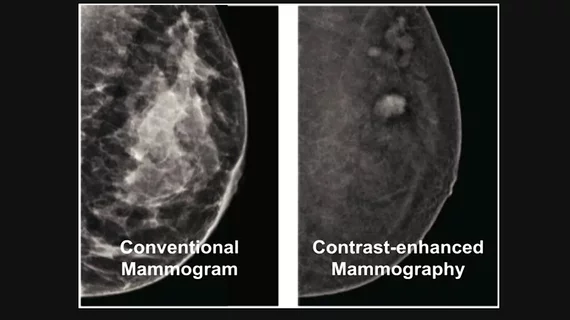Radiologists should be aware of these clinical factors when reading CEM scans
New data points to a number of clinical factors that radiologists need to consider in conjunction with contrast-enhanced mammography (CEM).
Factors such as breast cancer history, breast cancer treatment, menstrual status and more could affect the degree of background parenchymal enhancement (BPE) on CEM, which in turn could lead radiologists to misinterpret an exam. But new data indicates that radiologists need to be especially aware of the menstrual cycles of premenopausal women undergoing CEM because BPE is lower during certain days of the cycle.
These and other findings were published on Jan. 25 in the American Journal of Roentgenology.
“Background parenchymal enhancement (BPE) may impact contrast-enhanced mammography (CEM) interpretation, although factors influencing the degree of BPE on CEM are poorly understood,” corresponding author of the paper Yajia Gu, with the Department of Radiology at Fudan University Shanghai Cancer Center, and colleagues wrote.
Previous studies on how clinical factors affect BPE have rendered conflicting results and focused mostly on breast MRI, authors of the new study noted. For this study, experts wanted to explore whether these factors had any impact on CEM interpretations.
A total of 207 women who had undergone CEM exams were included in the analysis. Two radiologists interpreted the exams, which researchers later compared alongside patients’ medical records to establish relationships between BPE and documented clinical factors.
The experts found that the degree of BPE was negatively associated with age, personal history of breast cancer, history of chemotherapy, history of radiation therapy, perimenopausal status and postmenopausal status. In contrast, positive associations were observed with dense breasts and premenopausal status with irregular menstrual cycles.
For premenopausal women with regular cycles, BPE was lowest during days 8 to 14 of their cycle.
Elaborating on these findings, the authors suggested that menstrual status, including any cycle irregularities, might affect BPE more than age.
“Breast tissue is hormonally sensitive, and BPE is known to be affected by endogenous and exogenous hormone levels,” the authors explained. “Thus, these associations may represent decreases in estrogen hormone levels and in fibroglandular tissue as patients age.”
Since these factors could influence the diagnostic performance of CEM, the authors suggested that they should be considered when scheduling patients for CEM and that radiologists should keep them in mind when interpreting the exams.
The study abstract is available here.

